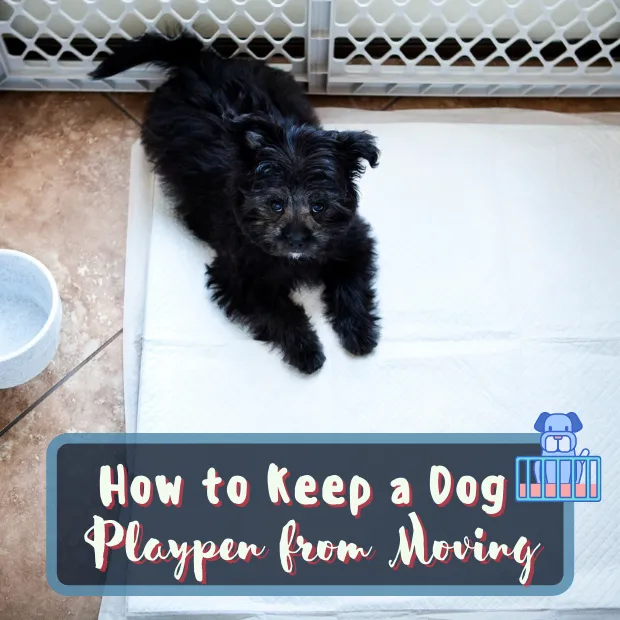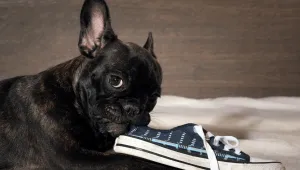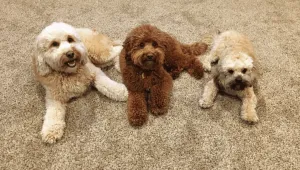If you have a puppy, then you know that they can get pretty excited and wiggly at times.
This can make it difficult to keep their playpen in one spot, especially if you have hardwood or tile floors – so how can you stop your puppy’s playpen from wandering across the room?
In this post, we will share some tips on how to keep a dog playpen from moving around!
Table of Contents
ToggleChoose the right playpen for your dog.
First and foremost, you will want to make sure that you choose the right size playpen for your dog.
If the playpen is too small or too lightweight for your dog’s breed and size, then your pup will probably be able to move it around easily.
In general, metal playpens are the best choice for puppies since they are more durable and difficult to chew through. Opt for a heavy playpen if you’re not likely to be moving it around too much.
Try to find one that is on the heavier side, especially if you have a large breed pup. This will make it more difficult for your pup to push around. You can also try adding some weight to the bottom of the playpen, we will cover this later on in the article.
If you have more than one puppy, consider using two or more playpens to prevent fights.
Have a look at some great playpens for your pup here.
What do you put under a dog playpen?
The type of flooring that you have in your home will also make a difference in how easy it is for your pup to move their playpen. If you have hardwood or tile floors, then your pup will be able to push the playpen around more easily than if you have carpet.
One way to keep your dog’s playpen from moving around on hardwood or tile floors is to put something under the legs of the playpen. This can be anything from small rubber furniture pads to towels or blankets. Just make sure that whatever you use is thick enough to grip the floor and prevent the playpen from sliding around.
You can also try using double-sided tape on the corners and edges of the playpen. This will create a powerful grip between the playpen and the floor, making it much more difficult for your pup to push it around. Just be sure to use tape that is safe for both your floors and your dog.
Stabilize the play pen with anchors
Anchors can provide a lot of stability. If your model doesn’t include any, keep in mind that anything heavy, flat-bottomed, and difficult to move is suitable. Some makeshift playpen anchors are:
- Concrete bricks.
- Kettlebells or weights.
- Heavy furniture.
- Sandbags.
If you have the space, you can position the playpen against one or two walls to stop it moving around so much. Use anchors on the sides of the playpen that are not touching a wall to secure it in place.
You can also use zip ties to attach the playpen to furniture or other heavy objects in your home. Just make sure that whatever you use is safe for both your dog and your home.
Exercise your dog.
A tired dog is a good dog. If your pup is full of energy, they are more likely to try to escape their playpen or move it around. Make sure to give your pup plenty of playtime beforehand so that they are tired when it’s time to go in the playpen.
Minimize the time your dog spends in the playpen
If your dog is only in their playpen for a short period of time, they are less likely to try to escape. If you need to leave your pup in their playpen for an extended period of time, make sure to give them something to do. This can be anything from a Kong toy stuffed with treats to a chew bone.
They’re less likely to make an escape attempt if they’ve got something tasty and enjoyable to occupy them.
When should I stop using a playpen for my dog?
As your pup gets older, they will probably need less and less time in their playpen. They will also be better at behaving while in their playpen and be less likely to try to escape.
You can stop using the playpen once your pup is completely housetrained and has passed the “chewing-everything-in-their-path” phase. This can be anywhere from 6-18 months, depending on the breed of dog, but check out our article on what age is a dog the naughtiest for more info.
Even if your pup is fully grown, you may still need to use the playpen occasionally. If you have company over or there is a loud event happening outside, your pup may feel scared and need a place to retreat to. In these cases, the playpen can provide a safe space for your pup to relax in.
Final words on how to keep a dog playpen from moving
For puppies, a playpen is an essential tool for potty training and preventing bad habits such as chewing on furniture. To keep a playpen from moving, buy the heaviest one you can, consider the floor surface, anchor it to the floor or place it against a wall.
A dog playpen can help with housetraining, provide a safe space for your pup to explore, and keep them out of trouble when you can’t watch them. By following these tips on how to keep an exercise pen from moving, you can make sure your pup has plenty of room to run around (and stay safe) without destroying your home.
For information on alternatives to puppy pens such as crate training, check out this post.







